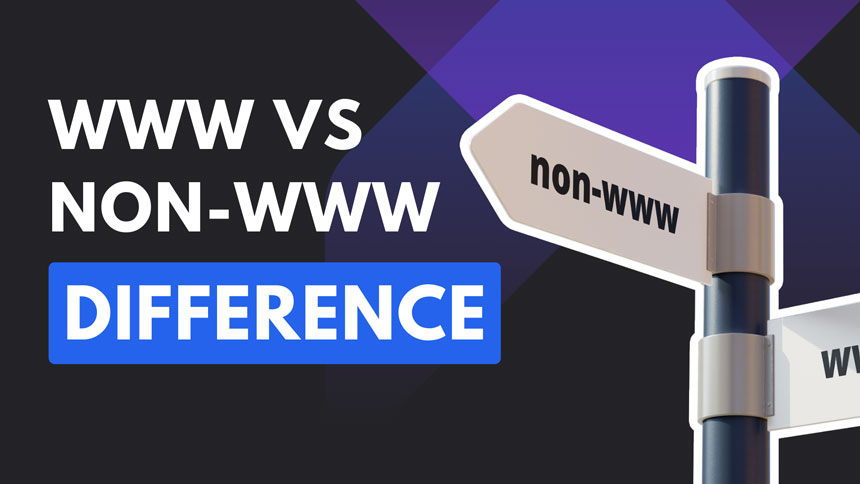So what is the difference between www and non-www domains? Are there any SEO benefits for choosing one over the other?
The short answer is no. There are no SEO advantages between the two we know about so far. So as a personal or small business owner, you should not worry about it. What is important tho, whatever version you choose, make sure to stick with it.
Personally, I like non-www domains more because they are simple, easier to type and work better for branding and promotional materials.
However, after a bit of digging, I found some key information I want to share with you so please keep reading…
The Important Part
Make Sure to Reroute All Traffic to One Domain
It’s very important to redirect all web traffic to one domain. So if you choose www as your main domain, you need to 301 redirect all the non-www URLs to this domain and vice versa. If you haven’t done this already, I have created a tutorial on how to redirect www to non-www and vice versa.
The reason why you need to do this is to prevent search engines from flagging your content as duplicate content. Getting your content flagged as duplicate content is actually harmful to your site’s SEO.
Because Google treats each domain as a separate website, if the same page is accessible on both versions you may run into a duplicate content issue.
Also, if you are using SSL, please check if your website automatically redirects all HTTP traffic to the HTTPS version. Check my tutorial on how to redirect HTTP to HTTPS if you are using WordPress.
Keep Your Domain Consistent
Whatever domain you choose, make sure to stick with it. If your website is already published and indexed by search engines, changing the domain now will do more harm than good. It really doesn’t worth losing your site traffic just to add or remove www to your domain.
Some browsers like Chrome even remove the www part from the URL and only display the organization domain.
For example, google.com appears like this in Chrome’s address bar
![]()
However, if you double-click the address bar, the actual domain is revealed as www.google.com
![]()
The Technical Difference Between www and non-www Domains
A non-www domain is called a naked domain and it represents the root domain that you buy (or more accurately, you rent for a year or more) from a domain registrar like Godaddy. A www domain, on the other hand, is called a subdomain.
A subdomain is a child domain of a parent domain. Just as in real life, a parent can have many children, a parent domain also can have many child domains. And these child domains can have child domains of their own.
Fun fact, a “branded” domain like example.com is also a child domain or subdomain of the .com top-level domain.
Subdomains are treated as separate domains by search engines and browsers. So basically, these are considered two different domains by Google and other search engines:
example.com www.example.com
People also tend to think www is part of the HTTP protocol but that’s not true. HTTP is the underlying protocol of the internet used by machines to communicate and transfer data on the web. www is just a prefix that a domain can have.
Why High-Traffic Websites Prefer www Domains? Cookie-free Domains Explained
According to this article, cookies set on the top domain example.com will be accessible on all its subdomains including www.example.com, however, cookies set on the www domain will not be accessible on other subdomains or the naked domain.
For this reason alone, some high-traffic websites prefer to use the www subdomain for their main content and create another subdomain to use as a CDN.
For example, by using the www.example.com domain as your main website and creating another subdomain for static content called static.example.com, this domain is considered cookie-free if you set no cookies on it. This means when the browser makes a request for a static file, it will not send a cookie alongside it and thus less network traffic on the bandwidth and the servers.
However, if you use example.com as your main website, all requests to static.example.com will include the top-level domain’s cookies.
It is easy to work around this by registering another domain and using it for static content and if you sign up for a CDN service, most of them will host your files on their domains anyway.
Why www Domains Were So Popular?

In the early days of the internet, even before the web, domains were used to host multiple services like mail, ftp, telnet, and these services were accessible using a combination of a domain, a prefix, and a port number. For example, ftp.example.com would be the FTP server for example.com.
When the web came along, most webmasters just created a www subdomain to host their web content. And this trend continued for years.
Eventually, the web become so popular that the words web and internet are used interchangeably. So we started using the top-level domain for web content.
Conclusion
In the end, choosing www or non-www for your website boils down to personal preference for most people.
However, whatever version you go with, it is important to stick with it and implement a redirect to reroute all web traffic to the domain you chose.
If you have any questions, please let me know if the comments below.

